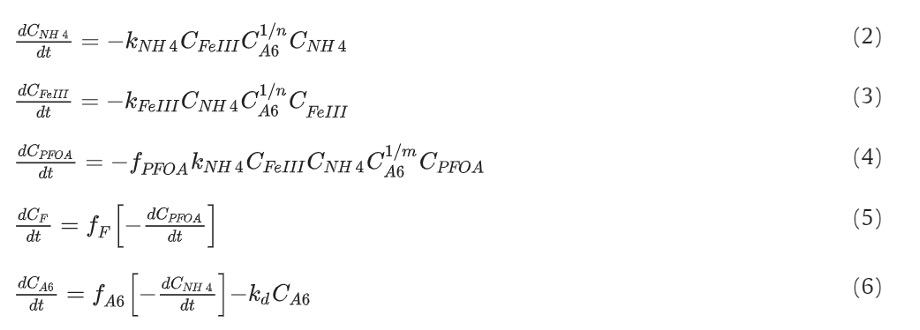PFAS Summit
Poster Session
 Camila Llerena-Olivera1,2
Camila Llerena-Olivera1,2
4th year Ph.D. candidate
Principal Investigator: Peter R. Jaffé1
with Jinyue Jiang1,2, Shan Huang1, and Z. Jason Ren1,2
1 Department of Civil and Environmental Engineering, Princeton University
2 Andlinger Center for Energy and the Environment, Princeton University
Finding the Ideal Microbial Electrolysis Cell Conditions with Acidimicrobium sp. Strain A6 to Enhance Ammonium Oxidation and PFAS Defluorination in Wastewater
Abstract
Currently, there is no EPA-approved method to remove PFAS from wastewater. Our lab is exploring how we can use microbial electrolysis cells (MECs) with a bacteria strain called Acidimicrobium sp. Strain A6 to oxidize ammonium and defluorinate PFAS as a possible wastewater treatment technology. One big challenge of upscaling this technology is that A6 is a gram-positive bacterium. As a result, it does not form biofilms on the anode surface and needs a chemical mediator such as 9,10-anthraquinone-2,6-disulfonic acid (AQDS) to assist with electron shuttling. While AQDS is good for ammonium oxidation for MECs with A6, it inhibits A6’s ability to defluorinate PFAS. It is hypothesized that anode material with a high surface area plays an important role in A6’s MEC performance. Initial experiments have shown that a MEC with a carbon brush anode and continuous stirring, A6 is retained in the anode via filtration, ammonium oxidation occurs, and AQDS may no longer be required. Further investigation is needed for MEC experiments that include PFAS.
Bio
Llerena-Olivera earned her bachelor’s degree and master’s degree in Environmental and Ecological Engineering from Purdue University. During her master’s degree, she learned about PFAS and its remediation challenges while working at an internship with the Indiana Department of Environmental Management. Her current research interests include microbiology, electrochemistry, and environmental technology. She collaborates with the Z. Jason Ren lab group at Princeton to develop microbial electrolysis cell prototypes for PFAS defluorination. After completing her doctoral degree, she hopes to assist the industry, government, and/or non-profit sectors with her multidimensional perspective on environmental issues.
 Jinhee Park1
Jinhee Park1
4th year Ph.D. candidate
Principal Investigator: Peter R. Jaffé1
with Shan Huang1 and Bruce E. Koel2
1 Department of Civil and Environmental Engineering, Princeton University
2 Department of Chemical and Biological Engineering, Princeton University
Strategic Iron Oxide Modification to Optimize Acidimicrobium sp. Strain A6 Activity for PFAS Bioremediation
Abstract
Microbial degradation of per- and polyfluorinated compounds (PFAS) presents significant challenges due to the robust carbon-fluorine bonds characteristic of these compounds. Despite this, Acidimicrobium sp. strain A6 (A6) has demonstrated a unique capability to defluorinate PFAS, utilizing ammonium oxidation and iron (III) oxide reduction under anaerobic conditions to release fluoride and generate shorter-chain PFAS molecules. A critical factor in promoting A6-mediated PFAS degradation in environmental settings is the strategic deployment of iron oxides. In this context, we explored the effectiveness of ferrihydrite, the most bioaccessible iron oxide, modified with a polyacrylic acid (PAA) coating. This modification aims to optimize the zeta potential, reducing the tendency of positively charged ferrihydrite to bind with negatively charged sediments, thus enhancing its distribution. Initial results from 50-day incubations indicate that PAA-coated ferrihydrite not only supports ammonium oxidation and PFOA degradation but also appears to foster a more diverse microbial community, as evidenced by increased operational taxonomic unit (OTU) counts. Building on these findings, our future work will delve into how different iron oxide types affect the competitive interplay between A6 and iron-reducing bacteria. By pinpointing iron oxides that selectively boost A6 activity, we aim to identify those that are optimal for facilitating efficient PFAS degradation. This line of inquiry is crucial for refining bioremediation strategies and ensuring the targeted efficacy of A6 in contaminated environments, particularly in the face of competition from iron-reducing bacteria such as Geobacter species.
Bio
Jinhee earned her bachelor’s degree in Environmental Science and Engineering from Ewha Womans University and her master’s degree in Civil and Environmental Engineering from Seoul National University. Jinhee’s research interests lie in designing the optimal conditions for A6-mediated PFAS degradation, with a particular focus on the employment of iron oxides. Jinhee’s goal is to contribute to the development of practical field approaches for PFAS remediation. Jinhee collaborates with researchers from the Department of Chemical and Biological Engineering, aiming to enhance the interdisciplinary reach of her work. Jinhee has been published in Journal of Hazardous Materials and holds Korean patents for the treatment of arsenic-contaminated soils using iron oxides. Looking forward, she is dedicated to furthering her research on environmental remediation techniques and expanding her collaborative network to include projects that aim for sustainable and efficient environmental cleanup.
 Mansha Seth-Pasricha1
Mansha Seth-Pasricha1
Associate Research Scholar
Principal Investigator: Jose L. Avalos 1,2
with Shan Huang3, Peter R. Jaffe3
1 Department of Chemical and Biological Engineering, Princeton University
2 Andlinger Center for Energy and the Environment, Princeton University
3 Department of Civil Engineering, Princeton University
Utilizing a Novel Microbe for Fast and Efficient Breakdown of PFAS
Abstract
PFAS (per- and polyfluoroalkyl substances) are a large group of synthetic chemicals used in the manufacturing of products ranging from water-resistant clothing to high-performance firefighting foams. They are highly persistent chemicals that accumulate in soil and water causing adverse effects on human and ecosystem health. The soil microbe Acidimicrobium sp. A6 (A6), isolated by Professor Peter Jaffé’s group (PU) from riparian wetland soils in New Jersey, was recently reported to degrade these chemicals by breaking the extremely strong carbon-fluoride bond (dehalogenation) via novel genes called dehalogenases encoded in the genome of A6 genome. However, A6 is slow growing (~10 days doubling time), lacks tools for genetic engineering and takes > 60 days to break down PFAS. The Avalos group recently tested an easy to grow and genetically tractable novel microbe that can dehalogenate PFAS in ~48 hours. The preliminary data in the Avalos group provides a tantalizing avenue for testing the breakdown of the most extensively used group of PFAS known as PFOA along with the production of potential fluorinated compounds as a by-product that presumably causes cell death of the microbe. Building on this encouraging finding, our goal is to utilize this microbe for the high throughput breakdown of PFAS in a wide range of ecological contexts.
Bio
Seth-Pasricha earned a bachelor’s degree with honors in Biochemistry and a PhD in Microbiology and Molecular Genetics. Her research interests include exploring early evolving microbes, understanding their evolutionary trajectories, and utilizing their metabolic potentials to address problems in sustainable energy, the environment, and human health. Seth-Pasricha has worked with early evolving Archaea to understand evolution of cell death proteases in her PhD, on the evolution of double-stranded RNA bacteriophages in her postdoc, and in reproductive medicine and hereditary cancer in the precision medicine industry. At Princeton, she is collaborating with researchers in the department of Civil Engineering on various projects including PFAS bioremediation, production of a microbially-manufactured net negative CO2 Biocement, and on the microbial sequestration of industrially relevant metal ions from industrial wastes.
 Mansha Seth-Pasricha1,a, Shan Huang3,b
Mansha Seth-Pasricha1,a, Shan Huang3,b
Associate Research Scholara
Professional Specialistb
Principal Investigator: José L. Avalos1,2
Peter R. Jaffé3
1 Department of Chemical and Biological Engineering, Princeton University
2 Andlinger Center for Energy and the Environment, Princeton University
3 Department of Civil and Environmental Engineering, Princeton University
Development of Biocatalysts for the Degradation of PFAS “Forever” Chemicals
Abstract
PFAS (per- and polyfluorionated alkyl substances), used in the manufacturing of many products ranging from non-stick coatings to high-performance firefighting foams, are highly persistent chemicals that accumulate in water, soil, and air potentially for centuries. Their ability to bioaccumulate also poses health risks to humans and ecosystems. The soil bacterium Acidimicrobium sp. strain A6 (A6) which contains genes for a novel reductive dehalogenase (rdhA), a fluoroacetate dehalogenase (FceA) and two putative haloacid dehalogenases (dhl1 and dhl2), can defluorinate the very recalcitrant perfluoralkyl acids, although the role of the specific enzymes is not clear nor if additional enzymes are involved. A major challenge is the exceedingly slow growth rate of A6 (~10 day doubling time) and lack of genetic tools, which severely limits the use of A6 for PFAS bioremediation. We propose to tackle these obstacles by developing new synthetic biocatalysts to accelerate PFAS degradation based on A6 biochemistry, through (1) expressing the rdhA, FceA, dhl1, and dhl2 in E. coli and/or P. pastoris, which are fast-growing powerhouse hosts for the production and secretion of recombinant proteins (2) randomly mutagenize A6 to identify unknown enzymes or co-factors important or essential for PFAS degradation (3) develop a basic toolkit and methods to genetically engineer A6.
Bios
Seth-Pasricha earned a bachelor’s degree with honors in Biochemistry and a PhD in Microbiology and Molecular Genetics. Her research interests include exploring early evolving microbes, understanding their evolutionary trajectories, and utilizing their metabolic potentials to address problems in sustainable energy, the environment, and human health. Seth-Pasricha has worked with early evolving Archaea to understand evolution of cell death proteases in her PhD, on the evolution of double-stranded RNA bacteriophages in her postdoc, and in reproductive medicine and hereditary cancer in the precision medicine industry. At Princeton, she is collaborating with researchers in the department of Civil Engineering on various projects including PFAS bioremediation, production of a microbially-manufactured net negative CO2 Biocement, and on the microbial sequestration of industrially relevant metal ions from industrial wastes.
Huang is a Professional Specialist in the Department of Civil and Environmental Engineering at Princeton University. During her Ph.D. in Environmental Biotechnology at Sun Yat-Sen University in China, she focused on the nitrogen cycle, examining related microorganisms and genes across various environments. At Princeton, Huang’s research focuses on the Feammox reaction, a process linking ammonium oxidation with iron reduction in oxygen-limited wetland environments. She identified a Feammox bacterium, Acidimicrobium sp. Strain A6, known for its PFAS degradation potential, characterized by its genome that contains multiple dehalogenase genes. Her research aims to gain insights into the function of these dehalogenases in the defluorination process, investigate the impact of PFAS on environmental microorganisms, and explore PFAS defluorination in natural environments. Furthermore, Huang is developing bioaugmentation strategies with A6 to address PFAS contamination in biosolids, making a substantial contribution to the field of environmental engineering.
 Matthew Sima1,2
Matthew Sima1,2
4th year Ph.D. candidate
Principal Investigator: Peter Jaffe 1
HMEI STEP Advisor: Denise Mauzerall 1,2
1 Department of Civil and Environmental Engineering, Princeton University
2 School of Public and International Affairs, Princeton University
Understanding the Kinetics and Application of PFAS Biodegradation by Acidimicrobium Sp. Strain A6 via Modeling and Column Experiments
Abstract
In 2019, the Jaffe lab showed the ability of A6 to defluorinated PFOA and PFOS via a coupling process with the Feammox reaction (ferric ammonium oxidation). This process has since been elucidated in my kinetic model as shown below:

Here, the model states that PFOA defluorination is directly related to the amount of ammonium removal multiplied by the concentration of PFAS. Both the Feammox process and PFOA defluorination are not linearly related to A6 concentration due to the limited surface area of the Ferric Iron. Since the model development, my research has expanded to include systems with multiple PFAS to better simulate natural conditions and show that the degradation of one PFAS species is not affected by the presence of others.
In addition, my research investigates the application of PFAS biodegradation in natural soils and the potential policies governing PFAS in agriculture. By amending natural soils with ammonium, ferric iron, and adjusting of pH, we have stimulated A6 to remediate PFAS in two different AFFF-impacted sites along the North Atlantic Coastal Plane. This is supported by the production of F– and a rigorous fluorine balance along with the increase in an A6-specific reductive dehalogenase.
Bio
Matthew earned a dual bachelor’s degree in Biology and Environmental Policy from Duke University. His research interests include understanding the mechanisms behind the biodegradation of PFAS and investigating the policies surrounding PFAS mitigation and remediation from both water and soil. He is a Ph.D. candidate in the Princeton Civil and Environmental Engineering Department and a Fellow through the High Meadows Environmental Institute Science, Technology, Environmental Policy program with leadership roles in both the Graduate Student Government and the Graduate Engineering Council. Matthew has published in Science of the Total Environment and Journal of Hazardous Material, and co-authored papers in Environmental Science and Pollution Research and Nature among others. Matthew is also the CEO and co-founder of his startup AEREA inc., a scientific research editing and advising service. He plans to apply for professorships this upcoming year and graduate in the spring of 2025.
 Chiara Smorada1
Chiara Smorada1
3rd year Ph.D. candidate
Principal Investigator: Peter R. Jaffé1
with Shan Huang1
1Civil and Environmental Engineering Department, Princeton University
Investigation of PFAS Defluorination Mechanism by Acidimicrobium sp. Strain A6
Abstract
In laboratory batch incubations with highly enriched cultures of A6 (Acidimicrobium sp. Strain A6), defluorination of PFOA has been observed at the alpha-carbon to produce H-PFOA. We hypothesize that A6 (an autotrophic bacterium) can cleave the carbon-fluorine bonds of PFAS. Heterotrophs in the mixed microbial consortia can subsequently cleave the carbon-carbon bonds of PFOA to yield shorter-chain PFAS compounds. Laboratory batch incubations with pure and enrichment cultures of A6 spiked with small PFAS molecules containing various fluorine substitutions will be used to investigate A6’s defluorination mechanism. During the incubations, degradation products, gene expression, and PFAS removal will be monitored.
Bio
Smorada earned a bachelor’s degree in chemistry (Saint Mary’s College, IN) and a bachelor’s degree in environmental engineering (University of Notre Dame, IN). At Princeton University, she studies biological remediation of PFAS in river water, sediment, and mineral medium laboratory batch incubations. One of her major projects aims to elucidate a PFAS degradation mechanism by Acidimicrobium sp. Strain A6. Most recently, she is learning to conduct bioinformatics work to study the A6 genes that may be important for defluorination of PFAS. She hopes her research can contribute to advancing the field of PFAS bioremediation.
Joel William Strothers1
4th year M.S.E candidate
Principal Investigator: Peter R. Jaffe1
1 Department of Civil and Environmental Engineering, Princeton University
Enhancing PFAS Removal in Wastewater Biosolids Through Seeding with Acidimicrobium sp. A6: A Continuous Defluorination Approach
Abstract
This research aims to develop a process for the biodegradation of poly- and perfluoroalkyl substances (PFAS) in sludge from wastewater treatment plants. PFAS are persistent, recalcitrant, and hazardous chemicals widely used in consumer products. Once they enter waste treatment plants, they tend to accumulate in the biosolids, presenting a significant challenge as conventional removal methods are often inadequate. This study introduces an innovative approach using Acidimicrobium sp. Strain A6 for the defluorination of PFAS-contaminated biosolids, building on preliminary and promising laboratory results. It proposes a series of Feammox incubations to assess the extent of PFAS defluorination in anaerobically digested biosolids. The Feammox process involves the oxidation of ammonium (NH4+) to nitrite (NO2-) and the reduction of ferric iron [Fe(III)] to ferrous iron [Fe(II)].
The cornerstone of this research is the use of Acidimicrobium sp. Strain A6 to defluorinate PFAS during the Feammox process. Metagenomic analysis reveals that A6’s genome contains genes for a novel dehalogenase enzyme, which is actively expressed during PFAS defluorination. The experimental design includes collecting sludge cake samples from local wastewater treatment plants to ascertain the moisture content that aligns with the initial biosolids matrix moisture post-inoculation.
The study aims to offer a biological model of the process and plans for its mass-scale application in wastewater treatment facilities. This research promises to advance the development of an effective, efficient, and sustainable method for PFAS removal from wastewater, enhancing water quality and reducing health risks.
Bio
Strothers is an MSE student at Princeton University and has earned a B.S. in Environmental Science from CUNY Medgar Evers College. His scientific endeavor began with groundbreaking research in advanced biofuels, marking his entry into the scientific community with notable publications. Joel’s expertise was further honed through prestigious internships at NASA’s Goddard Space Flight Center and NOAA Crest, broadening his research spectrum.
Currently, Strother’s work focuses on the critical environmental issue of PFAS removal from wastewater sludge, showcasing his dedication to finding sustainable waste solutions. His commitment extends beyond research; Strothers is a fervent mentor to students of color in STEM, aiming to empower the next generation of scientists. Additionally, his contributions to community healthcare in underserved areas highlight his holistic approach to service and advocacy in both environmental and public health spheres.
 Xiaohui Xu1
Xiaohui Xu1
Associate Research Scholar
Principal Investigator: Rodney Priestley1
with Nehemie Guillomaitre1
1 Department of Chemical and Biological Engineering, Princeton University
Design of Solar Absorber Gel for PFAS Remediation
Abstract
According to the United Nations, in the last century, global water demand grew more than twice as much as the population did. To mitigate water crisis, our research focuses on harnessing the potential of solar absorber gels for effective removal of various regulated contaminants, including organic molecules, oils, metals, and pathogens. Notably, our investigations reveal promising results in the removal of PFAS from water using solar absorber gels. Currently, our research endeavors are directed towards the development of hydrogel photocatalysts tailored for water purification. We aim to enhance PFAS degradation and adsorption capabilities through the integration of advanced photocatalytic materials, thereby offering a novel solution to the pressing challenge of water contamination.
Bio
Xu obtained her Ph.D. from Chang’an University in 2019 and undertook her thesis research at Helmholtz-Zentrum Berlin for Material and Energy (HZB) in Germany. After that, she worked as a Presidential Postdoctoral Fellow in Chemical and Biological Engineering at Princeton University. She is also a co-founder of Aquapao, a startup company founded in 2021 dedicated to addressing the global water crisis. Her research focuses on the fundamental understanding and engineering of soft materials, particularly in the realms of polymer synthesis, characterization, and their applications in environmental sustainability. Recent recognitions include the Newsweek’s inaugural list America’s Greatest Disruptors: Mind Blowers, Fast Company’s inaugural Most Creative People in Business. Xu also collaborates with researchers in the Department of Civil and Environmental Engineering and Department of Mechanical Engineering. Dr. Xu has published in ACS Central Science, Advanced Materials, Macromolecules, JACS Au, and ACS Applied Materials & Interfaces. Xu will begin as an assistant professor at Rowan University in the spring of 2025.
 Edward Zhang1
Edward Zhang1
Undergraduate Class of 2024
Principal Investigator: Peter Jaffe1
with Matthew Sima1
1 Department of Civil and Environmental Engineering, Princeton University
Investigation of Key Parameters for Bioremediation of PFAS in Biosolids Mediated by Acidimicrobium Sp. Strain A6
Abstract
A6 bacteria has been shown to biodegrade PFAS chemicals, but challenges for using A6 in industry bioremediation applications include the exposure to a wide range of temperatures and also the necessity of an Fe(III) source. A6 bacteria is shown to be highly influenced by temperature, showing low activity at 10oC and 15oC. Previous experiments showed that iron is typically the limiting reagent in the Feammox reaction and requires continuous reapplication during incubations. Here, we show that the residual iron from ferric chloride and other iron compounds added during wastewater treatment processes is bioavailable for A6 and sufficient to sustain A6 growth.
Bio
Edward is a senior pursuing a bachelor’s degree in civil and environmental engineering. He has worked in internships in non-profit water/wastewater utilities advisory and water engineering consulting. These experiences piqued his interest in the water sector and the remediation of emerging contaminants, which he is pursuing in his senior thesis working in the Jaffe Lab. Edward is a member of the Princeton Pianist Ensemble and Princeton Club Badminton Team. After graduation, Edward will be working as a water resources engineer, focusing on stormwater resiliency.
 Ian Bourg1,2
Ian Bourg1,2
Associate Professor
with Jennifer A.R. Willemsen1, Amélie Lemay1, Ethan Sontarp1
1 Department of Civil and Environmental Engineering, Princeton University
2 High Meadows Environmental Institute, Princeton University
Molecular Dynamics Simulation Prediction of the Partitioning of PFAS Between Water, Air, and Mineral Surfaces
Abstract
The tendency of PFAS to partition between water, air, and mineral surfaces is an important set of properties that impacts their fate and transport in natural systems. A key challenge in predicting this partitioning is the need for accurate equilibrium constants for a wide variety of PFAS between many phases or interfaces and over a variety of chemical conditions. Molecular dynamics (MD) simulations have the potential to facilitate the generation of these data, but they have been applied only to a limited number of compounds and adsorbents. Bourg’s team reports MD simulations of the partitioning of a variety of PFAS (including cationic, anionic, and zwitterionic compounds and PFAS precursors) at water-air and mineral-water interfaces in different aqueous chemistry conditions. Simulation results provide quantitative predictions of adsorption and partitioning coefficients and fundamental insight into the mechanisms that control these coefficients.
Bio
Bourg is an associate professor in civil and environmental engineering at Princeton University. His group studies the properties of water at interfaces, with a particular emphasis on the impact of clay minerals on subsurface hydrology, soil mechanics, carbon dynamics, geochemistry, and contaminant fate and transport. He obtained a B.Eng. in industrial process engineering from the National Institute for Applied Sciences in Toulouse in 1999 and a Ph.D. in civil and environmental engineering from the University of California at Berkeley in 2004. He led a research group in the earth sciences division at the Lawrence Berkeley National Laboratory until 2014 before joining the faculty at Princeton University in 2015.
